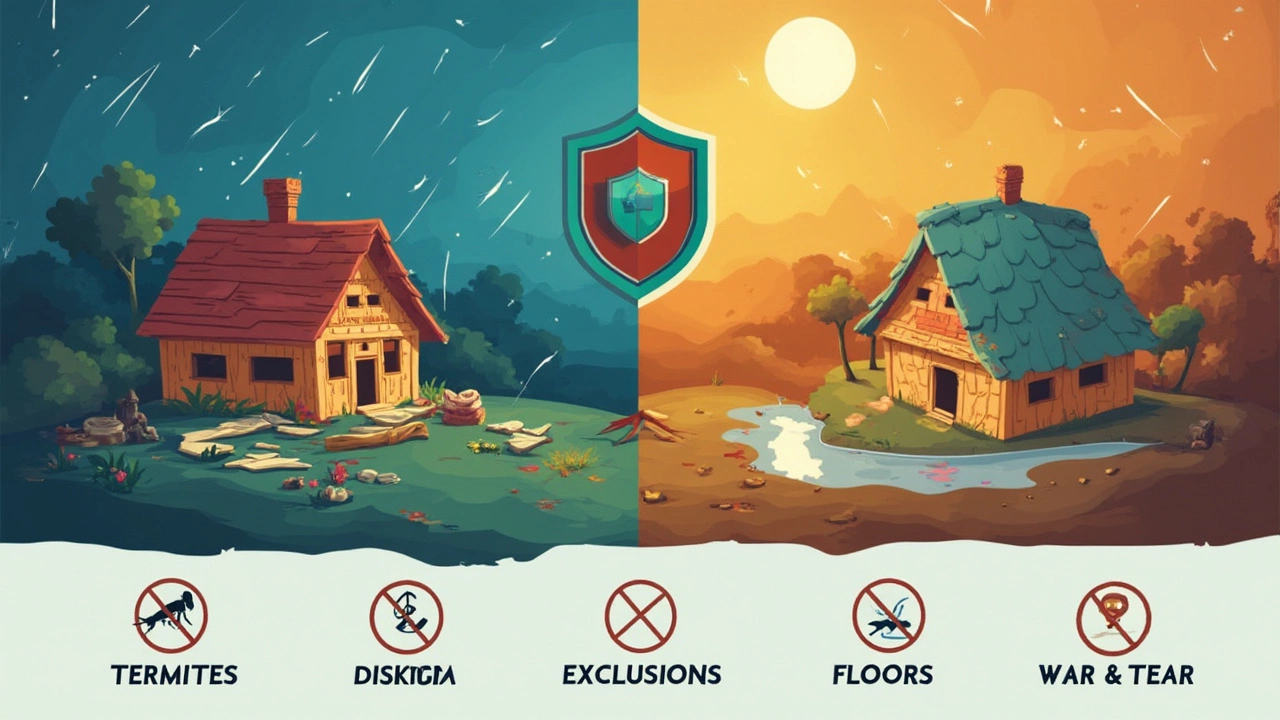Imagine waking up to a loud crack, racing downstairs, and finding a huge split in your living room wall. That question hits you every time: does my insurance have my back?
Understanding Structural Damage and Home Insurance
Most folks think insurance is like a magic shield that zaps away every home problem. Not really. Insurance policies often dance around what they call “structural damage.” To the average person, that’s stuff like giant wall cracks, sinking foundations, or even roofs buckling in after a rough winter. But, to insurance companies, “structural damage” can mean something totally different, and not every scenario is covered. You might be surprised—the fine print is where dreams go to die.
So, what IS structural damage exactly? It covers harm done to the important frameworks of your house. Think foundation, load-bearing walls, beams, and the roof. It’s the stuff keeping your home upright. Cosmetic issues, like peeling paint or a broken tile, don’t count. Insurers focus on the stuff that literally makes your home stand, not just look good.
Now, not every policy covers every kind of risk. Standard homeowner insurance, more often than not, covers “sudden and accidental” structural damage. That means if a wicked storm sends a tree crashing into your roof, you’re probably okay. The same goes if a kitchen fire weakens your beams or if a freak gas blast shakes up your walls.
But—here’s the curveball—most policies draw hard lines. They’ll say no to claims if the cause was gradual or preventable. If it’s a slow leak eating away at your foundation for years or you skipped a year of roof maintenance and that’s what caused the collapse, chances are you’ll have to pay for the fix yourself. It’s the “wear and tear” and “neglect” exclusions you’ll always find in your policy, usually buried in a ten-pound booklet nobody reads for fun.
Here’s an easy way to think about it: Was the damage sudden and out of your control? Your odds are better. Did it build up slowly or could you have stopped it? The odds just tanked.
Common Causes of Structural Damage and Coverage
Time to get down and dirty—what actually causes the kind of damage you care about? According to the Insurance Information Institute, most major claims come from water, wind, hail, fire, and theft. But when it comes to structural damage specifically, certain culprits pop up more than you’d think.
- Storms: Hurricanes, tornadoes, and just wild windstorms send debris flying. If a tree falls on your house or a tornado takes off your roof, most policies have your back—unless you live in some high-risk zone where separate wind coverage is required.
- Fires: Fires rip apart everything, right down to the beams. Fire damage? Almost always covered under homeowners’ insurance, unless you started the fire yourself (don’t do that).
- Plumbing mishaps: Pipes burst, bathrooms flood—it’s a nightmare. Sudden incidents that cause structure damage usually make the list, but slow leaks and mold creeping in over months get rejected fast.
- Earthquakes and floods: Here’s where things get tricky. Standard home insurance rarely, if ever, covers earthquake or flood damage. That’s a separate policy. Only about 8% of US homeowners have earthquake insurance, even in riskier areas.
- Pests: Termites, carpenter ants, rats—any judge on insurance planet Earth will kick this one out. Anything labeled as “preventable” is usually not covered.
- Normal settling: Every house creaks and settles a bit. If the foundation cracks from just growing old or ground shifting naturally, prepare to shell out.
The real shocker? A 2023 report by the National Association of Insurance Commissioners found that water damage (excluding floods) was responsible for about 23% of all home insurance claims. Yet, many of these claims were denied due to “gradual” versus “sudden” damage. That’s why it helps to document when and how you noticed things going wrong. A photo of a collapsing ceiling dated yesterday versus a years-old crack can make thousands of dollars’ difference.
So, pay close attention to your policy’s named perils and exclusions. High wind areas, coastal zones, or regions prone to quakes often force homeowners to buy special add-ons. Don’t just guess—ask your agent exactly what is (and isn’t) on the list.

Types of Insurance Policies and Structural Damage
Insurance policies speak their own weird language, but you only need to know a few to get by. The most common for regular folks is the HO-3 policy. It covers your house structure for nearly every sudden event—unless specifically excluded. If your policy is “named perils,” then only the risks literally listed are covered. “All-risk” or “open peril” means everything is covered unless mentioned as an exclusion. Read carefully—wording changes everything.
HO-3 (“Special Form”) home insurance is the US standard. If you’re in Canada or other countries, terms might differ, but the basics are pretty similar. HO-3 shields your home's structure, your stuff, and protects you from lawsuits. What it usually doesn’t cover: damage from floods, earthquakes, earth movement, neglect, wear, war, pest infestations, or faulty construction.
HO-5 policies (for fancier homes) work like HO-3s but tend to offer broader open-peril coverage on personal belongings too. HO-1 and HO-2 are older and cover less—think budget or very basic risks. Landlord and renter policies (HO-4, HO-6) split responsibility for structure versus personal belongings, but the basic exclusions are similar.
Earthquake and flood policies are add-ons—totally separate contracts, even with the same provider. In California, for example, most insurers partner with the California Earthquake Authority. Flood insurance? That usually runs through FEMA’s National Flood Insurance Program. Private flood insurance is getting popular too, especially in coastal or hurricane-prone states like Florida and Louisiana.
Just to drive the point home: If your foundation cracks because a faulty sewer line floods the ground, your regular insurance likely waves goodbye, unless you have a special rider. On the other hand, if a meteor falls out of the sky—which, weirdly, is covered as a “falling object” in most policies—you’ll get a check. Insurers work in mysterious ways.
Making a Claim: Dos, Don’ts, and Insider Facts
The moment you spot damage, you might freeze up. Don’t. Fast action can be the difference between payout and rejection. First thing—document everything. Snap photos, take video, grab witnesses if you can. Insurers love evidence and hate guessing games.
Here are some steps that can make or break your insurance claim:
- Contact your insurer as soon as you notice significant damage. Waiting around only makes things look suspicious.
- Tarp up that roof, shut off the main water, board up the window—anything to stop more damage. Most policies require you to act “reasonably” to keep things from getting worse. There’s a name for this: “mitigating damage.”
- Don’t touch evidence. Don’t throw out parts of the wall or beams before the inspector arrives. If you have to clean up for safety, save what you can or take photos first.
- Meet the adjuster, walk them through every crack and creak. Be honest, but don’t underplay the issue.
- Keep track of every call, every email, and every visit. Some people even keep a damage diary—sounds nerdy, but if your claim gets pushed back, you’ll be grateful.
Smart tip: If your claim is denied but you believe the damage was sudden or was a covered peril, don’t just sigh and walk away. Challenge it. Many people win on appeal, especially when they present clear evidence or hire a neutral contractor for another opinion. And in some states, you can take it to a government-backed review board or even court.
Here’s a quick table (based on 2024 industry stats) to see what percent of claims in each category got approved last year:
| Cause | Claims Approved (%) | Common Reason for Denial |
|---|---|---|
| Storm Damage | 88 | Not covered peril, lack of evidence |
| Fire | 97 | Intentional cause |
| Water Damage (not flood) | 53 | Gradual, not sudden |
| Earthquake | 10 | No earthquake policy |
| Flood | 15 | No flood policy |
| Settling/Old Age | 3 | Wear and tear/Uninsurable |
| Pest Infestation | 2 | Preventable/Neglect |
As you can see, there’s a big gap between how people think insurance works and what actually gets paid. Knowing this can help you decide if you need better coverage or a different provider.

Tips for Better Coverage and Preventing Denials
The best way to avoid claim headaches? Prep before damage ever happens. Insurance experts recommend a policy review every year, especially after big house upgrades or neighborhood shifts—like if your area suddenly starts flooding more or grows a new termite problem.
One hack: Make a video walk-through of your whole house, inside and out, every year or so. Store it on your phone or in the cloud. If disaster hits, you’ll have time-stamped proof of what your place looked like before, making life a lot easier for everyone involved.
Don’t skip maintenance—fix loose shingles, seal cracks, keep records. If you can prove you took good care of your home, insurers rely less on “neglect” as a reason to duck out.
Make sure you know the difference between replacement cost and actual cash value. Replacement cost policies pay what it takes to fully fix or rebuild, regardless of depreciation. Actual cash value pays you what your old, worn-out roof was worth—not enough for a full repair, usually. The cost difference in premiums is often worth it for the peace of mind alone.
Remember deductibles: a higher deductible saves you on monthly premiums but means you pay more out of pocket if something happens. Make sure it's a number you can really afford in a pinch.
If you’re in a high-risk area, seriously consider specialty insurance. Don’t wait until you’re knee-deep in water or picking up bricks after an earthquake. The cost upfront is usually less than what repairs will set you back without coverage.
